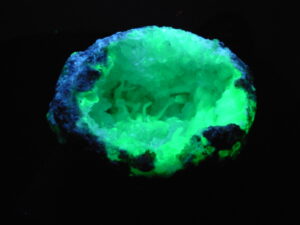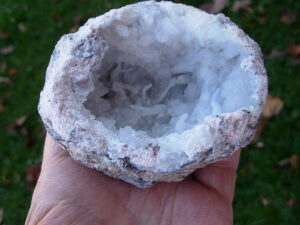Geodes
There are conflicting views about how geodes form, but most geologists agree that they begin as bubbles, sometimes in submarine limestone sediments, sometimes in a lava flow. Occasionally they form around the body of a sea creature on the ocean floor. Over time, the bubble is cast in a hard shell of silica, and water containing dissolved material is trapped inside. The precipitate that results is composed of a variety of minerals, usually quartz or calcite, but also aragonite, magnetite, barite and chalcopyrite. Many thousands of years later, weathering lifts the hard little silica orb away from the surrounding rock. The exterior of the sphere appears dull and pitted, which is no doubt why the Greeks called them “geoides”, meaning "earth like". However, on the inside, they can look heavenly. The precipitate forms a lining of inward projecting crystals and since different minerals harden at varying temperatures, the material forms layers(called Fortifications). Sometimes a cavity may be completely filled by layers. Purists refer to these geodes as nodules. Crack open a nodule and instead of a hollow crystalline core, you might find halos of brilliantly hued agate, produced where chalcedony-laden water precipitated within the shell. Geodes can also be filled with surrounding silt and sediments, forming a “mud ball.” If a crystal breaks off inside the geode, you can hear rattling (the only guarantee of a hollow geode!), these are often called “rattle stones”. Occasionally, water gets trapped in the geodes, forming what is called an “enhydro”, (Greek for “water inside”).
WHERE TO FIND GEODES
The best locations to look are in deserts - the western states, especially Arizona, Utah, and Nevada are popular hunting grounds. California's Riverside and Imperial counties are particularly renowned for their geodes, as is Keokuk, Iowa, Mexico, Australia, Germany, Uruguay and Brazil.
Click on Geode Name below to go to that Geodes Page
Arkansas Geodes
Arkansas Geodes are very similar to a mix of Aragonite rich Kentucky Geodes and the Keokuk crystal geodes.
Dugway Geodes
6 to 8 million years ago, volcanic activity in Western Utah deposited an igneous rock called rhyolite. Trapped gases formed pockets in the rhyolite, which eventually became lined with chalcedony and quartz from groundwater. Most Dugway Geodes fluoresce a lime green color due to minute amounts of a secondary mineral that bonded with the quartz when it was growing. 32,000 to 14,000 years ago, a large lake covered most of Western Utah. The lakes wave activity eroded the rhyolite and actually moved the geodes several miles away to their current location in Juab County, Utah.
Choyas(Mexican Coconut) Geodes
Choyas geodes are mined in a 44 million year old volcanic deposit in an area of Chihuahua, Mexico called Las Choyas. Nicknamed “coconut geodes” because of their roundness and size, Choyas are literally hand dug with a pick axe out of tough bentonite clay. Miners fill potato sacks with the geodes and raise them up narrow shafts from 75 to 125 feet beneath the surface! Composed mainly of any variety of quartz, including the ever popular amethyst, Choyas are especially fascinating because of the wide variety of secondary minerals found in them.
Brazilian Agate Geodes
Brazilian geodes are worked in a large open pit mining operation in Rio Grande de Sol, Brazil. These geodes are filled with beautiful layers of banded agate that form under relatively low temperatures of 45-54°F and pressures. A striking feature of the agate is the occurrence of dendritic inclusions resembling trees, bushes or even sunbursts, caused by a mineral growth of manganese oxide.
Oco (Occo,Ocho) Geodes
“Oco’s”, is the word used in Brazil where they are found, are tiny agate nodules with a geode center. The formation in which the geodes are found is 50 million years old and located in the country of Brazil. Farmers have gathered the Oco’s for many years. After the crops have been harvested and the farmers are unable to work, the fields are tilled under allowing the Oco’s to appear. They are then gathered and sold for cutting into the geode half."
Tabasco Geodes
Tabasco geodes (aka "ilianites") were introduced in the mid 1970's in Zacatecas, Mexico by the owner of the Rancho Agua Blanca near Tabasco, Zancatecas. This owner was the first to actually mine these small geodes. They were first brought to the USA by Luis Arzola of Juarez, Chihuahua, naming them after his daughter iliana.
Delma Perry of El Paso Texas was the first to electroplate these magnificent small geodes (ilianites) and the rush was soon on as every jewelry house in the USA had to have these. They played out soon thereafter. A new claim was filed in 1995 on a new location, but that site was only an acre or so and quickly played out.
Keokuk Geodes
Iowa geodes have long been objects of curiosity, their sparkling interiors containing some of the most beautiful crystals to be found anywhere in the Midwest. Although geodes are known from many localities around the world, one of the most productive and famous collecting regions is encompassed within a 35-mile radius of Keokuk, Iowa. Rock collectors commonly refer to geodes from this region as "Keokuk geodes." In keeping with the world-renowned status of the Iowa geodes, the Iowa General Assembly declared the geodes as the official "State Rock" in 1967.
Missouri Monster Geodes
These exciting and very rare geodes were located and excavated by Michael Streeter NC Professional Geologist, Photographer & Rockhound. These were found in an area adjacent to a road construction project where geodes up to 2 ft in diameter were found. They were available for the digging for one day...and crushed by road equipment the next...a once in a lifetime find!
Mooralla Geodes
Mooralla or Anderson’s Creek, is located west of the Grampians in western Victoria near the Rocklands Reservoir. The township of Mooralla consisting mainly of a few buildings, is a few kilometres to the southeast. Access is via a rough track, which is often difficult to travel on, particularly following bouts of wet weather. The collecting area itself is Victoria’s only "fossicking reserve", and is "looked after" by the Horsham Gem Club. The treasured smoky quartz "geodes" that have been highly sought since the 1960s, occur in a decomposing rhyolite, and are sometimes described as miarolitic cavities. Where once good specimens could be extracted from near the surface, holes are now dug down to depths approaching 6 metres in the main part of the field. For those that like smaller specimens, loose crystals, or the other minerals that are occasionally found, shallow holes to about 2 meters deep at the perimeters of the field will fulfill their needs.
Idar-oberstein Geodes
Geodes from the twin towns of Idar-Oberstein in the Nahe region of Germany are now very rare to find. Once abundant these agate geodes have all but disappeared from the collecting world. Through the years Idar-oberstein has become known as the gem cutting capital of the world. Sadly, all the local specimens have been well picked over and famous quarry's like the Setz are all now closed down. Most of the gems and stones from this famous location are now imported from Brazil.
Mexican Reverse Scepter Amethyst Geode
These rare geodes are from a single source undisclosed location deep in the mountains of Mexico. We were lucky to get some of these before they disappeared into the annals of time, and may never be seen again
Kentucky Geodes
Kentucky geodes are "Yard Decorations" according to locals. The Aragonite geodes sometimes have voids which display beautiful caverns. The more solid chalcedony and quartz geodes display yellows, reds and blues
Trancas Geodes
Mexican “Trancas” geodes were first found in 1973 and are surface mined about 220 miles south of El Paso, Texas near Estacion Rancasm Aldama, Chihuahua province, Mexico. These geodes are not as common as the coconut geodes. They contain mostly clear or drusy chalcedony quartz linings and may have secondary calcite or fluorite. Trancas Geodes have a fluorescent glow due to trace uranium content similar to Dugway Geodes. Under shortwave UV light, most of these geodes fluoresce bright green.
Geodes from Other Locations
Geodes on this page are from Various locations around the world. Some VERY unique and Different Geodes that we find will be shown on this page. These are all "One of a Kind" items. There are many Specialty Geodes from the Deccan Plains and Morocco
San Andreas Fault Geode
Very Rare Geode finds from the infamous San Andreas Fault Zone

How To Open A Geode
There are many different ways to open a geode, but no matter how you do it, the key is to be patient and not get in a hurry. If you want the geode to break into two halves, you absolutely cannot just hit it as hard as you want to with a hammer! If the geode is hollow, you will shatter it into many pieces, not split it into two halves.
HAMMER and CHISEL METHOD
This is the most popular way to open a geode since most people have a hammer and chisel available around the house or in a toolbox versus some of the more specialized methods that mainly rock collectors have that are listed below. To open a geode with a hammer and chisel, score the geode all the way around the circumference of the geode with the chisel. Use a flat-faced (regular) chisel end versus the pointed type, since the force from a pointed chisel will tend to shatter the geode. With the flat chisel you have a better chance of opening the geode along the line you want it to open on. Continue scoring until you see a crack develop in the geode, and then follow the crack around the geode until it opens. If the geode is hollow you must be very careful not to hit the chisel too hard with the hammer. Start lightly at first and then strike progressively harder until a crack develops.
SOCK METHOD
This is the most popular method for smaller geodes usually under 2 or 3 inches. Place the geode in a sock, twist the sock to tightly contain the geode, and hit very lightly with a hammer. (A brick layer’s hammer works the best in our experience if this is being done by an adult). This method is mainly used in groups with children to protect pieces from flying and injuring someone. The chances of having the geode break in two are not as good with this method as with the hammer and chisel method, but it is still possible. We strongly suggest this method when having children open the geode themselves for everyone's safety as children tend to swing the hammer as hard as they possibly can.
Choyas(Mexican Coconut) Geodes
Choyas geodes are mined in a 44 million year old volcanic deposit in an area of Chihuahua, Mexico called Las Choyas. Nicknamed “coconut geodes” because of their roundness and size, Choyas are literally hand dug with a pick axe out of tough bentonite clay. Miners fill potato sacks with the geodes and raise them up narrow shafts from 75 to 125 feet beneath the surface! Composed mainly of any variety of quartz, including the ever popular amethyst, Choyas are especially fascinating because of the wide variety of secondary minerals found in them.
PIPE CUTTER METHOD
Opening geodes with a soil pipe cutter is a more specialized method, and these tools are usually only found among serious rockhounds. Pipe cutters have a chain that contains sharpened carbide-tipped roller blades that is wrapped around the geode and tightened. Unless the geode is extremely hollow or thin-skinned, the success rate for opening a geode into two nearly equal halves is very high with a pipe cutter and the process very quick. We use a Ridgid, model 276 which cuts from 2” to 6” diameter geodes (and pipe). Some tool rental places may have these available for rent at a much cheaper price than purchasing one of these. They cost in the $500.00 range to purchase.
SAW CUTTING
This is the most expensive method by far of opening geodes. Lapidary saws run in the $1500.00 plus range for a saw large enough to cut sizable geodes. The main problem with sawing geodes is to tightly hold the geode in place while at the same time not applying so much pressure that the geode breaks from the vise. Some geodes such as Keokuk Geodes should not be cut with a saw as this process always destroys interior minerals such as calcites or selenite blades if the minerals are along the path of the saw blade. Cracking the geode may avoid these crystals as well as giving the shell of the geode a more natural look. Mexican "coconut" geodes, Indiana Geodes, Kentucky Geodes and many others can be sawed open but you still run the risk of damaging interior minerals. Many of these geodes, however, do look very attractive polished and some like the Mexican coconuts have features that go un-seen without polishing such as 3-D holographic type effects in parallel banded geodes


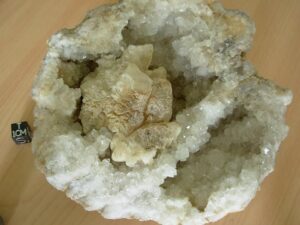
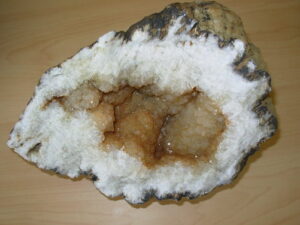
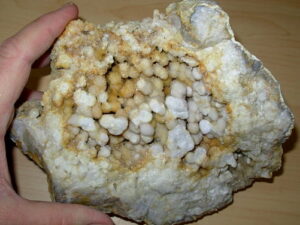 Arkansas Geodes are very similar to a mix of Aragonite rich Kentucky Geodes and the Keokuk crystal geodes.
Arkansas Geodes are very similar to a mix of Aragonite rich Kentucky Geodes and the Keokuk crystal geodes.
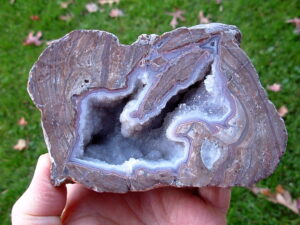
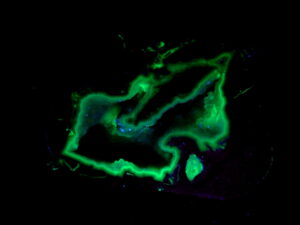
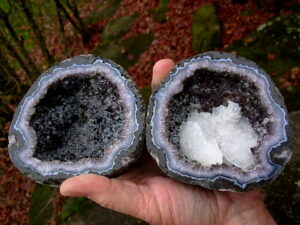
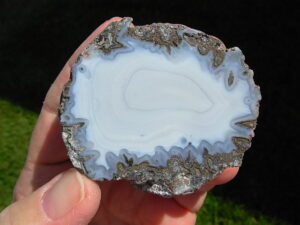
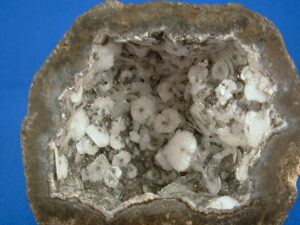 Choyas geodes are mined in a 44 million year old volcanic deposit in an area of Chihuahua, Mexico called Las Choyas. Nicknamed “coconut geodes” because of their roundness and size, Choyas are literally hand dug with a pick axe out of tough bentonite clay. Miners fill potato sacks with the geodes and raise them up narrow shafts from 75 to 125 feet beneath the surface! Composed mainly of any variety of quartz, including the ever popular amethyst, Choyas are especially fascinating because of the wide variety of secondary minerals found in them.
Choyas geodes are mined in a 44 million year old volcanic deposit in an area of Chihuahua, Mexico called Las Choyas. Nicknamed “coconut geodes” because of their roundness and size, Choyas are literally hand dug with a pick axe out of tough bentonite clay. Miners fill potato sacks with the geodes and raise them up narrow shafts from 75 to 125 feet beneath the surface! Composed mainly of any variety of quartz, including the ever popular amethyst, Choyas are especially fascinating because of the wide variety of secondary minerals found in them.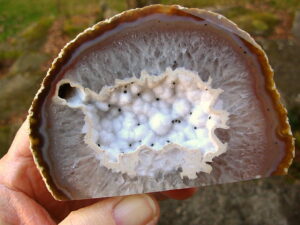
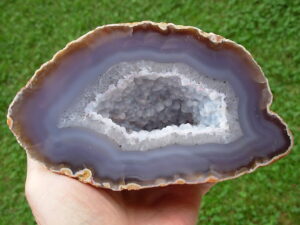
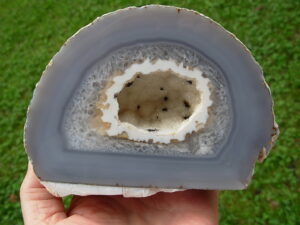
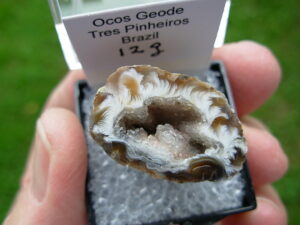
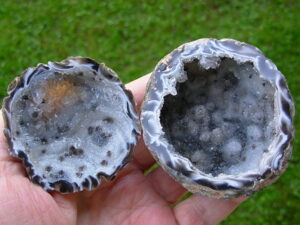
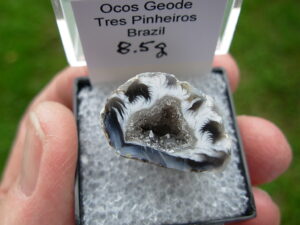 “Oco’s”, is the word used in Brazil where they are found, are tiny agate nodules with a geode center. The formation in which the geodes are found is 50 million years old and located in the country of Brazil. Farmers have gathered the Oco’s for many years. After the crops have been harvested and the farmers are unable to work, the fields are tilled under allowing the Oco’s to appear. They are then gathered and sold for cutting into the geode half."
“Oco’s”, is the word used in Brazil where they are found, are tiny agate nodules with a geode center. The formation in which the geodes are found is 50 million years old and located in the country of Brazil. Farmers have gathered the Oco’s for many years. After the crops have been harvested and the farmers are unable to work, the fields are tilled under allowing the Oco’s to appear. They are then gathered and sold for cutting into the geode half."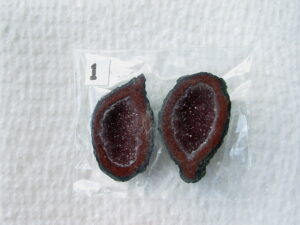
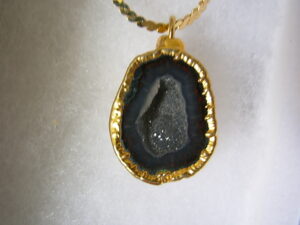
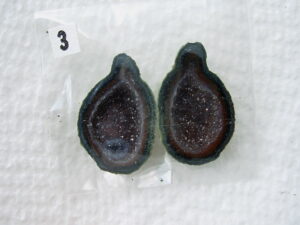 Tabasco geodes (aka "ilianites") were introduced in the mid 1970's in Zacatecas, Mexico by the owner of the Rancho Agua Blanca near Tabasco, Zancatecas. This owner was the first to actually mine these small geodes. They were first brought to the USA by Luis Arzola of Juarez, Chihuahua, naming them after his daughter iliana.
Tabasco geodes (aka "ilianites") were introduced in the mid 1970's in Zacatecas, Mexico by the owner of the Rancho Agua Blanca near Tabasco, Zancatecas. This owner was the first to actually mine these small geodes. They were first brought to the USA by Luis Arzola of Juarez, Chihuahua, naming them after his daughter iliana.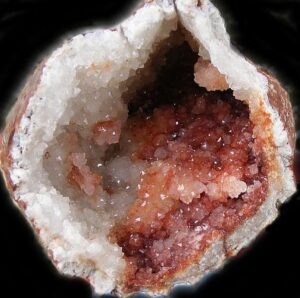
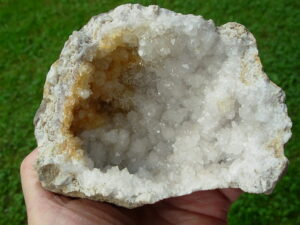
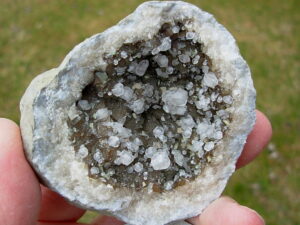 Iowa geodes have long been objects of curiosity, their sparkling interiors containing some of the most beautiful crystals to be found anywhere in the Midwest. Although geodes are known from many localities around the world, one of the most productive and famous collecting regions is encompassed within a 35-mile radius of Keokuk, Iowa. Rock collectors commonly refer to geodes from this region as "Keokuk geodes." In keeping with the world-renowned status of the Iowa geodes, the Iowa General Assembly declared the geodes as the official "State Rock" in 1967.
Iowa geodes have long been objects of curiosity, their sparkling interiors containing some of the most beautiful crystals to be found anywhere in the Midwest. Although geodes are known from many localities around the world, one of the most productive and famous collecting regions is encompassed within a 35-mile radius of Keokuk, Iowa. Rock collectors commonly refer to geodes from this region as "Keokuk geodes." In keeping with the world-renowned status of the Iowa geodes, the Iowa General Assembly declared the geodes as the official "State Rock" in 1967.